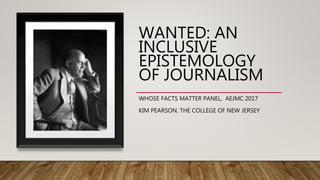Wanted: An Inclusive Epistemology of Journalism
- 1. WANTED: AN INCLUSIVE EPISTEMOLOGY OF JOURNALISM WHOSE FACTS MATTER PANEL, AEJMC 2017 KIM PEARSON, THE COLLEGE OF NEW JERSEY
- 2. COMPUTATION AL JOURNALISM: A CHALLENGE, AND AN OPPORTUNITY Journalism at scale Rethinking inclusion A culturally-responsive epistemology
- 3. JOURNALISM AT SCALE: FOR WHOM? BASED ON WHAT? Robotic reporting Who is writing the algorithms? How are reporting rules and story structed? Tech and journalism diversity issues Social computational crowdsourcing and verification How do you avoid enshrining bigotry? Racism in Google images, chat bots Data mining How is data vetted? How are limitations addressed? GIGO ŌĆō How, particularly, do we contextualize faulty historical data?
- 4. PARALLELS AND DISCONTINUITIES Computational journalism era ŌĆó Journalism at scale ŌĆó Social computational methods ŌĆó Data mining and analysis ŌĆó Credibility as a market positioning tool and civic imperative ŌĆ£ObjectiveŌĆØ journalism ŌĆó New tech, design and business models expanded methods for reaching audiences, transmitting stories, images ŌĆó Emphasis on ŌĆ£credibleŌĆØ sourcing, reporting, interviewing ŌĆó New social science methods: statistics, cultural anthropology ŌĆó Credibility as a market positioning tool
- 5. LESSONS FROM AN EARLIER ERA ŌĆó Several scholars, including David Mindich, have pointed to ways in which ŌĆ£objectiveŌĆØ journalism at the turn of the 20th century was compromised by ingrained biases. ŌĆó Ray Stannard BakerŌĆÖs process in reporting his 1908 book, ŌĆ£Following the Color LineŌĆØ serves as an interesting case study because of his use of authoritative black sources and social science pointing to cultural, not biological view of race.
- 6. RAY STANNARD BAKER 1870-1946 ŌĆó Leading practitioner of New Journalism ŌĆō interviews, storytelling, design for readability ŌĆó Muckraker ŌĆō worked with Lincoln Steffens, Ida Tarbell ŌĆó Wrote fiction as ŌĆ£David GraysonŌĆØ ŌĆó Close to Woodrow Wilson ŌĆō became his assistant, biographer
- 7. FOLLOWING THE COLOR LINE (1908) ŌĆó Prompted by Atlanta Riots of 1906, past reporting on lynching ŌĆó Interviewed black and white sources throughout South, North and Midwest ŌĆó Sent drafts for review to Du Bois, and Booker T. Washington ŌĆó Du Bois challenged his representation of white fear of black crime; Washington got him to report on incarceration and use of black convicts for profit ŌĆó Relies on elite representations of non- elites ŌĆō some of the elites happen to be black
- 8. CORRESPONDENCE WITH DU BOIS
- 9. SAME DATA, DIFFERENT ŌĆ£TRUTHSŌĆØ: WHY?
- 10. ECHOES OF THE PAST Natalie Byfield reported the Central Park Jogger story, then studied the press coverage for her book, Savage Portrayals:"This case became an extreme example of how new narratives about racial groups based on the notion of color-blind racism make it possible for the use of racist tropes from the past and the existence of unequal racial outcomes to be dismissed by mainstream institutions as having little or no relationship to the country's historical and material foundations of racial inequality."
- 11. AS WE BUILD JOURNALISMŌĆÖS FUTURE News, increasingly, is a designed product based on the researched needs of a particular set of users. If we are to solve the problem of generating news that is deemed credible because it conforms to ingrained, but unsubstantiated bias, we have to approach inclusion with an understanding of the ways in which ŌĆ£objectiveŌĆØ ways of knowing can subvert our search for truth. Ramesh Srinavasan argues for an approach to technology design that might be constructively adapted to journalism. Like the traditional technology developer, the ŌĆ£objectiveŌĆØ journalist stands outside of a community. Srinivasan criticizes social sciences that ŌĆ£remain closed to the description, categorization and ontologies that fail to fit within the Western or technocratic canon.ŌĆØ Rather, he advocates for ŌĆ£praxis:ŌĆØ ŌĆ£a collaborative process by which we listen, learn and practice humility.ŌĆØ (Whose Global Village)
Editor's Notes
- #2: I should begin by saying that I am not a historian. My study of journalism history is search for ways to improve the depth and breadth of contemporary and future practice. My research has been in developing curricular models for interdisciplinary computational journalism collaborations. Some of those models also involve community engagement.
- #9: BakerŌĆÖs treatment of black crime reflected Susan JacobyŌĆÖs criticism of false balance in ŌĆ£objectiveŌĆØ journalism ŌĆō giving equal or greater weight to compelling, but unrepresentative anecdotes as opposed to data that better reflects the broader reality.
- #12: Srinivasan: ŌĆ£Most user-centered design principles perpetuate a ŌĆśmaster-designer, God-type complexŌĆÖ by failing to consider the complexities fo culture, economy, education and politics. I am still working through my thoughts about this, but one idea I am advocating is developing hybrid classes in which journalism students study alongside members of the communities in which their schools are located, and develop news products together.











